- Latest SAPUI5 Version 1.120
- Version 1.118
- SAPUI5 Version 1.116
- SAPUI5 Version 1.114
- SAPUI5 Version 1.112
- SAPUI5 Version 1.110
- SAPUI5 Version 1.108
- SAPUI5 Version 1.106
- SAPUI5 Version 1.104
- SAPUI5 Version 1.102
- SAPUI5 Version 1.100
- SAPUI5 Version 1.98
- SAPUI5 Version 1.96
- SAPUI5 Version 1.94
- SAPUI5 Version 1.92
- SAPUI5 Version 1.90
- SAPUI5 Version 1.88
- SAPUI5 Version 1.86
- SAPUI5 Version 1.84
- SAPUI5 Version 1.82
- SAPUI5 Version 1.80
- SAPUI5 Version 1.78
- SAPUI5 Version 1.76
- SAPUI5 Version 1.74
- SAPUI5 Version 1.72
- SAPUI5 Version 1.70
- SAPUI5 Version 1.68
- SAPUI5 Version 1.66
- SAPUI5 Version 1.64
- SAPUI5 Version 1.62
- SAPUI5 Version 1.60
- SAPUI5 Version 1.58
- SAPUI5 Version 1.56
- SAPUI5 Version 1.52
- SAPUI5 Version 1.50
- SAPUI5 Version 1.48
- SAPUI5 Version 1.46
- SAPUI5 Version 1.44
- SAPUI5 Version 1.42
- SAPUI5 Version 1.40
- SAPUI5 Version 1.38
- SAPUI5 Version 1.36
- SAPUI5 Version 1.34
- SAPUI5 Version 1.32
- SAPUI5 Version 1.30
- SAPUI5 Version 1.28
- SAPUI5 Version 1.26
- Latest SAPUI5 Version 1.120
- Version 1.118
- SAPUI5 Version 1.116
- SAPUI5 Version 1.114
- SAPUI5 Version 1.112
- SAPUI5 Version 1.110
- SAPUI5 Version 1.108
- SAPUI5 Version 1.106
- SAPUI5 Version 1.104
- SAPUI5 Version 1.102
- SAPUI5 Version 1.100
- SAPUI5 Version 1.98
- SAPUI5 Version 1.96
- SAPUI5 Version 1.94
- SAPUI5 Version 1.92
- SAPUI5 Version 1.90
- SAPUI5 Version 1.88
- SAPUI5 Version 1.86
- SAPUI5 Version 1.84
- SAPUI5 Version 1.82
- SAPUI5 Version 1.80
- SAPUI5 Version 1.78
- SAPUI5 Version 1.76
- SAPUI5 Version 1.74
- SAPUI5 Version 1.72
- SAPUI5 Version 1.70
- SAPUI5 Version 1.68
- SAPUI5 Version 1.66
- SAPUI5 Version 1.64
- SAPUI5 Version 1.62
- SAPUI5 Version 1.60
- SAPUI5 Version 1.58
- SAPUI5 Version 1.56
- SAPUI5 Version 1.54
- SAPUI5 Version 1.52
- SAPUI5 Version 1.50
- SAPUI5 Version 1.48
- SAPUI5 Version 1.46
- SAPUI5 Version 1.44
- SAPUI5 Version 1.42
- SAPUI5 Version 1.40
- SAPUI5 Version 1.38
- SAPUI5 Version 1.36
- SAPUI5 Version 1.34
- SAPUI5 Version 1.32
- SAPUI5 Version 1.30
- SAPUI5 Version 1.28
- SAPUI5 Version 1.26
List Report Floorplan
Intro
With a list report, users can view and work with a large set of items. This floorplan offers powerful features for finding and acting on relevant items. It is often used as an entry point for navigating to the item details, which are usually shown on an object page.
Usage
Use the list report floorplan if:
- Users need to find and act on relevant items within a large set of items by searching, filtering, sorting, and grouping.
- Users need to display the whole dataset using different visualizations (for example, as a table or as a chart), without requiring interactions between these visualizations. An example use case might be reporting.
- Users need to work with multiple views of the same content, for example on items that are “Open”, “In Process”, or “Completed”. Views can be switched using tabs, segmented buttons, or a select control.
- Drilldown is rarely or never used, or is only available via navigation to another page, and not as free or flexible drilldown within the page itself.
- Users work on different kinds of items.
Do not use the list report floorplan if:
- Users need to see or edit one item with all its details. Use the object page floorplan instead.
- Users need to find one specific item, and the item or an identifying data point is known to the user (such as a barcode). Use the initial page floorplan instead.
- Users need to work through a comparably small set of items, one by one. Use the worklist floorplan instead.
- Users need to extract knowledge or insights from data, either to better understand the current situation, or to identify the root cause for a certain value. Use the analytical list page instead.
- Charts are not only used for visualization. Users need to switch between integrated chart and table views (hybrid view). Use the analytical list page instead.
- Users need to see the impact of their action on a KPI. Use the analytical list page instead.
- Users need to see not only the result, but also the impact of their filter settings directly in a chart representation. Use the analytical list page instead.
Structure
The list report is a full screen floorplan based on the dynamic page. In addition to the SAP Fiori launchpad shell bar, the dynamic page contains the following areas:
- The header title: Use this to display a title or the variant for the whole page, filter information (if the header is collapsed), and a header toolbar with global actions, such as Share.
- The header content: Use this to display the filter bar or the smart filter bar.
- The content area: Use this to display:
- An icon tab bar (optional)
- One table/chart toolbar (per tab)
- One or multiple tables and/or charts. You can use any kind of table. If you use a chart, you can display the chart on its own (without a table), as an additional view for an existing table (switchable), or in addition to an existing table, where the chart and table are shown at the same time.
- The footer toolbar: If needed, use a footer toolbar to display the messaging button and finalizing actions.
Responsiveness and Adaptiveness
In general, the list report floorplan is responsive. However, there are exceptions if the following controls are used:
- Grid table, analytical table: Supported on desktop and tablet devices only. On smartphones, replace these tables with something else, such as a responsive table or a list. In rare cases, displaying only a chart on smartphones might also suffice.
- Tree table: Supported on desktop and tablet devices only. For smartphones, there is no equivalent alternative. In some cases, a tree, the category navigation pattern, or a chart might work.
- Smart table: The smart table is a wrapper around the different existing table controls. If a grid table, analytical table, or tree table is used inside the smart table, you will run into the issues mentioned above. On a smartphone, you can use a responsive table inside the smart table. For the tree table, you need to replace the smart table as described above.
For more details, see the respective guideline articles.
Guidelines
Standard Naming Conventions
For all objects, follow the standard conventions for action buttons, the object name, and the title in the shell bar. For more information see Manage Objects – Naming Guidelines and Launchpad Shell Bar – Page Title and Navigation Menu.
Header Title
Variant Management
Variant management is optional. If you use variants, apply them to the whole page. Use the variants to save and restore all settings for filters, selected tabs, all tables, and all charts.
Users can choose a default variant, which is selected every time the app is started.
Allow users to choose whether a variant should be executed automatically as soon as it has been selected. Not executing a variant automatically allows the user to add or remove filters before the dataset is updated. Provide this option only if the filter bar is in manual update mode. For live updates, this option is not required.
If variant management is not needed, show a title that describes the current view instead.
Filter Information
Display the filter information only if the header content is collapsed. Use the format Filtered By (x): followed by a comma-separated list of the filters currently applied. “x” stands for the number of applied filters.
Show up to 5 filters. If more filters have been applied, show an ellipsis (“…”) at the end of the string.
If no filters have been applied, show Filtered By: None.
Header Toolbar
Use the header toolbar for non-finalizing global actions, such as Share. Share opens an action sheet, which features Save as Tile (if the SAP Fiori launchpad is available), Send Email, and Share in SAP Jam (if SAP Jam is available). Show the Share button only if it makes sense for your application.
If the content area contains a grid table, an analytical table, a tree table, or any other content with its own scrollbar, display a Show Filters / Hide Filters button for expanding and collapsing the header content.
In addition, offer any other global, non-finalizing actions needed. Hide actions that cannot be used at all (for example, because of access rights). To save space on the header toolbar, group similar actions using a menu button.
For more information on global actions, see the guidelines for the header toolbar.
Header Content
The header content collapses when the user scrolls down the page (with a responsive table, list, or tree only), and expands again when the user scrolls back up. To avoid this automatic expand / collapse behavior, users can also pin the header content so that it always stays open. Persist the pin setting.
Users can also expand and collapse the header content by clicking the background of the title bar.
If you are using a grid table, analytical table, tree table, or any other content with its own scrollbar, allow users to explicitly collapse and expand the header content manually with a Show Filters / Hide Filters button on the header title.
When starting the application, expand the header content if no query was fired (and the table is therefore empty). Collapse the header content in other cases.
Header Content - Expand / Collapse Behavior
Filter Bar
The filter bar can contain a search field (optional). If you use the search field, the content shows only items that match both the search terms and the filter criteria.
Filters are applied to all content, including all tables and all charts. To improve performance, consider providing mandatory filter fields and/or default settings for filters.
The filter bar offers two different update modes:
- The live update mode (recommended) triggers filtering immediately whenever a filter setting is changed. If the search field is used, the search is triggered together with all filter settings with every letter typed.
- The manual update mode displays a Go button, which triggers the filtering. If the search field is used, the search is executed together with all filters as soon as the Go button is pressed.
Make sure that all tables and charts in the content area are in a busy state until the new data is available. Also ensure that the content is grayed out as soon as the filter settings do not correspond to the content shown (any table, property: showOverlay). This is usually the case if the content is not yet updated and the Go button needs to be triggered.
Use the manual update mode only if you run into performance problems while loading the table data.
Regardless of the update mode, make sure that the filter bar and the visible content match: The filter bar must always describe the items that are shown in the content area.
Content Area
General Layout
There are three basic list report layouts: simple content, multiple views, and multiple content. These are described in more detail below.
Simple Content
In most cases, the content consists of just a table toolbar and a table. If needed, provide an option to switch between the table and a corresponding chart view.
Multiple Views
For more complex scenarios, provide multiple views of the same content. Multiple views involve one or more of the following:
- Showing the same table, but with different columns.
- Showing the same table in different pre-filtered states. These states are usually based on a status column, for example, items that are Open, In Process, or Closed. Make sure that the corresponding filter is not offered on the filter bar.
- Differentiating between the items displayed in the content in some other fundamental way.
There are two options for switching between different views:
The first option is to replace the table title with a content switch. Use this approach if all views share the same sort and group states, as well as the same actions.
The content switch can be:
- A segmented button for up to three views
- A select control for more than three views, or if the number of views changes dynamically
If you have both a table title and a content switch, display the table title first, then the content switch. Place both on the left side of the table toolbar. Since the content switch is placed on the table toolbar, the same actions are shown for all views.
If you are using the content switch together with charts, ensure that the chart also reacts to the content switch. This can be done by:
- Filtering the data that influences the display of the chart
- Changing the measures and/or dimensions (for example, View by Country, View by Customer, …)
The second option for switching views is to show each view in a tab container of the icon tab bar. Use this approach if all views show different states of the same data (sort states, group states, as well as item selection). Using tabs also allows you to offer different actions on the table toolbar for each view.
Multiple Content
To support even more complex use cases, a list report floorplan can also contain multiple tables that display different kinds of objects. The filter bar settings are applied to all of these tables in parallel. For example, a customer overview list report might display different tables for invoices, deliveries, and overdue payments. All of these tables can be filtered for a specific customer and a specific date.
Display each table inside a tab container of an icon tab bar. This also allows you to offer different actions on the table toolbar for each table.
Icon Tab Bar
Use the text-only version of the icon tab bar. Display the number of items shown in the respective table on each tab (sap.m.IconTabFilter, property: count).
Table Toolbar
Display at least a table title (ideally with an item count) and icon-only buttons for sorting, grouping, and column settings. Do not offer additional filter settings on the table toolbar. For sort and group, show a view settings dialog with just the corresponding features enabled. For column settings, show the table personalization dialog. If you need more extensive functionality (for example, grouping or sorting on several levels, tables with more than 20 columns), use the P13n-Dialog with just the corresponding feature enabled.
If alternative visualizations are provided (such as charts), offer an additional view switch on the table toolbar. Triggering the switch replaces the current visualization with another one. If a table and chart need to be shown in parallel, offer a switch for the combined view.
In rare cases, you can offer an additional layout variant on the table toolbar. The layout variant stores view settings like the column order and the sort and group settings. If you use a layout variant, do not store the table settings in the filter variant. Offer this additional layout variant only if there is a strong use case for switching filter and layout variants independently. If there is no strong use case, or you are unsure, do not use a layout variant at all.
In addition, offer any other actions needed. Disable selection-dependent actions (such as Delete) if no items are selected, or if the action cannot be applied to the selected items. Always enable selection-independent actions (such as Add). To save space on the table toolbar, group similar actions using a menu button. For example:
- Release and Release with Conditions
- Add Contact and Replace Contact
- Edit Account and Edit Title
For more information on table/chart actions, see the guidelines for the table toolbar, the chart toolbar, and for managing objects.
Table
If there are no items to display, use the “no data” text of the corresponding table. Explain why the table is empty, and what the user needs to do to display items.
Examples:
- After starting the app, no filters are applied:
No filters set. To start, enter your search and filter settings and run the search. - The filter was executed, but no items were found. This can also happen if the list report was opened by a related app, and the filter criteria were transferred automatically:
No items found. Check the search and filter settings.
Navigation
There are three types of navigation at item level in the list report floorplan:
- Line item navigation: If applicable, allow navigation to a detail view (usually an object page) at line item level. Show a navigation indicator (chevron icon) for each line item that provides a detail view. In a list, tree, or responsive table, clicking the line item triggers the navigation.
In a grid table, analytical table, or tree table, clicking the navigation indicator triggers the navigation.
Another option is to use a link as the identifier for the line item. This link triggers the navigation. Use this only if the navigation indicator is being used for a different target.
Only show navigation indicators for target pages the user is authorized to access. - Drilldown navigation: If a line item contains aggregated data, allow navigation to a view that contains details for the aggregated amount. This is usually another list report. In this case, use a link to display the aggregated amount. If the table contains many columns with links, use the link options to provide different levels of highlighting.
In charts, offer the drilldown navigation link in the popover for the chart element. In this case, also navigate to the corresponding list report to show the details. - Cross navigation: If a line item contains cross-references to other entities, such as people or business objects, use a link to display the corresponding data point in the table. Triggering the link opens a quick view. Typically, the quick view displays basic details of the referenced object and a navigation link to another page (usually an object page) or another app that shows the object details.
Footer Toolbar
Use the footer toolbar to display the messaging button and finalizing actions. Only use the footer toolbar if finalizing actions for the whole page and/or the message popover are available.
Always show the footer toolbar in edit mode.
Hide actions that cannot be used at all (for example, if the user doesn’t have authorization). To save space on the footer toolbar, group similar actions using a menu button.
For more information on finalizing actions, see the guidelines for the footer toolbar.
Actions
(1) Global actions in the header toolbar
(2) Table actions in the table toolbar
(3) Line item actions
(4) Finalizing actions in the footer toolbar
1. Global Actions
Place actions that affect the entire page in the header toolbar in the header title (1). These include the following standard actions:
- Show Filters / Hide Filters: This button expands and collapses the header content. Show this button only if the list report contains a grid table, analytical table, or tree table.
- Share: This button opens an action sheet that contains actions like Save as Tile (if the SAP Fiori Launchpad is available), Send Email, and Share in SAP Jam (if SAP Jam is available). Show the Share button only if it makes sense for your application.
Hide actions that cannot be used at all (for example, because the user has no authorization). To save space on the header toolbar, group similar actions using a menu button.
Do not place actions that finalize the current process (“finalizing actions”) on the header toolbar of the header title, even if they affect the entire page.
For more information on global actions, see the guidelines for the header toolbar.
2. Table/Chart Actions
Place actions that affect the content of a table or chart in the table toolbar (2).
If an action applies only for selected items, disable it if no items are selected, or if the selected items don’t qualify for the action. For example:
- Disable Remove if no item is selected.
- Always keep Add enabled.
Exception: The user needs to specify where in the table the item should be added. In this case, disable Add if no items are selected, or more than one item is selected. - Always keep Edit enabled if it switches the whole table to edit mode. If Edit applies only to one item or to a selection of items, disable it if no item is selected.
- Disable object-specific actions if no item is selected.
- Disable actions that change the status of one or multiple items if no item is selected.
If qualifying items can be identified before the action is executed, show a message about how many of the selected items the action will be applied to. In other cases, show a corresponding message after the action was executed.
Hide actions that cannot be used at all (for example, because the user has no authorization). If you are using an icon tab bar, be aware that each tab contains its own table toolbar.
For more information on table and chart actions, see the guidelines for the table toolbar, chart toolbar, and for managing objects.
3. Line Item Actions
In rare cases, actions that affect a single item can be placed directly inside the line item. Use this only for specific, frequently used tasks (3). If the same action can also be applied to several items at once, feel free to also place it on the table toolbar. Nevertheless, if you do so, reconsider whether you really need to offer the action at line item level. Examples of line item actions include:
- Start/Stop (a batch job)
- Approve (an item)
- Assign (an item)
Do not disable line item actions. If an action cannot be used, hide it. This can be the case if the user has no authorization or the line item is in the wrong state.
4. Finalizing Actions
Place actions that trigger the end of a process and affect the entire page in the footer toolbar (4).
Examples:
- Save
- Cancel
- Submit
Please be aware: Even if you are using the icon tab bar, there is only one footer toolbar for all tabs.
Hide actions that cannot be used at all (for example, because the user has no authorization).
For more information on finalizing actions, see the guidelines for the footer toolbar.
Resources
Want to dive deeper? Follow the links below to find out more about related controls, the SAPUI5 implementation, and the visual design.
Elements and Controls
- Chart (guidelines)
- Filter Bar (guidelines)
- Floorplan Overview (guidelines)
- Icon Tab Bar (guidelines)
- Introduction to SAP Fiori Elements (guidelines)
- Table Overview (guidelines)
- Variant Management (guidelines)
Implementation
- Filter Bar (API)
- Icon Tab Bar (API)
- Responsive Table (API)
- List Report and Object Page (SAP Fiori elements developer guide)

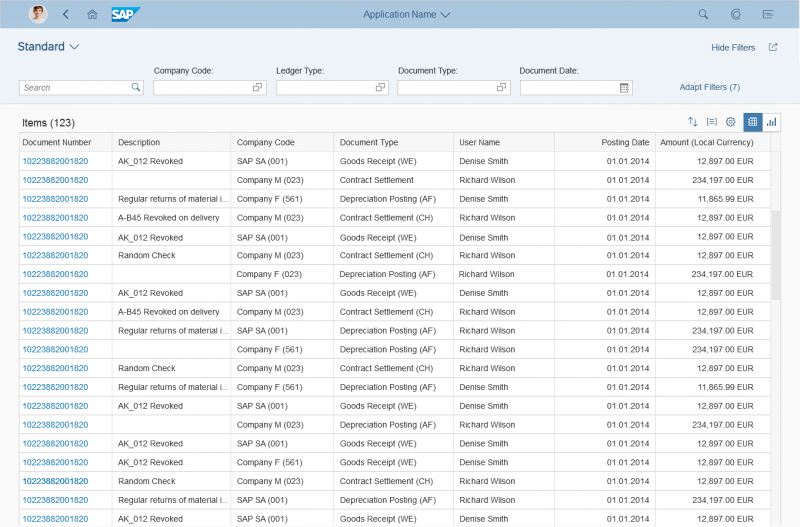
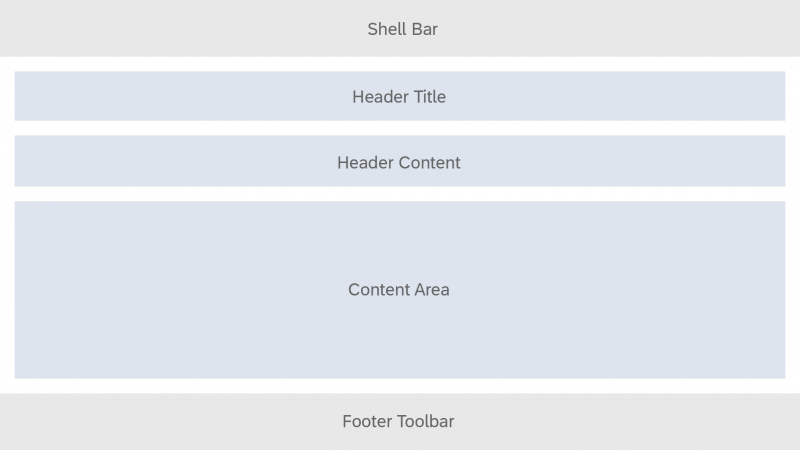
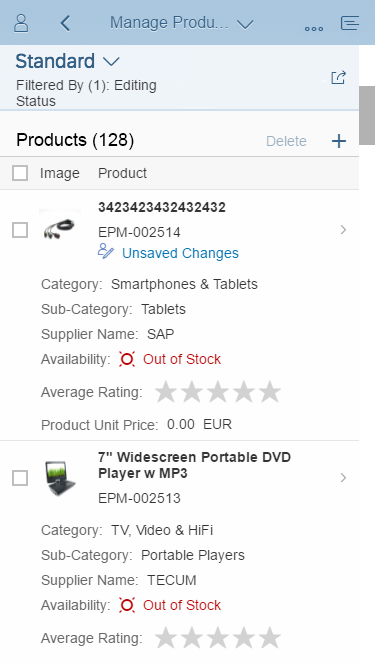
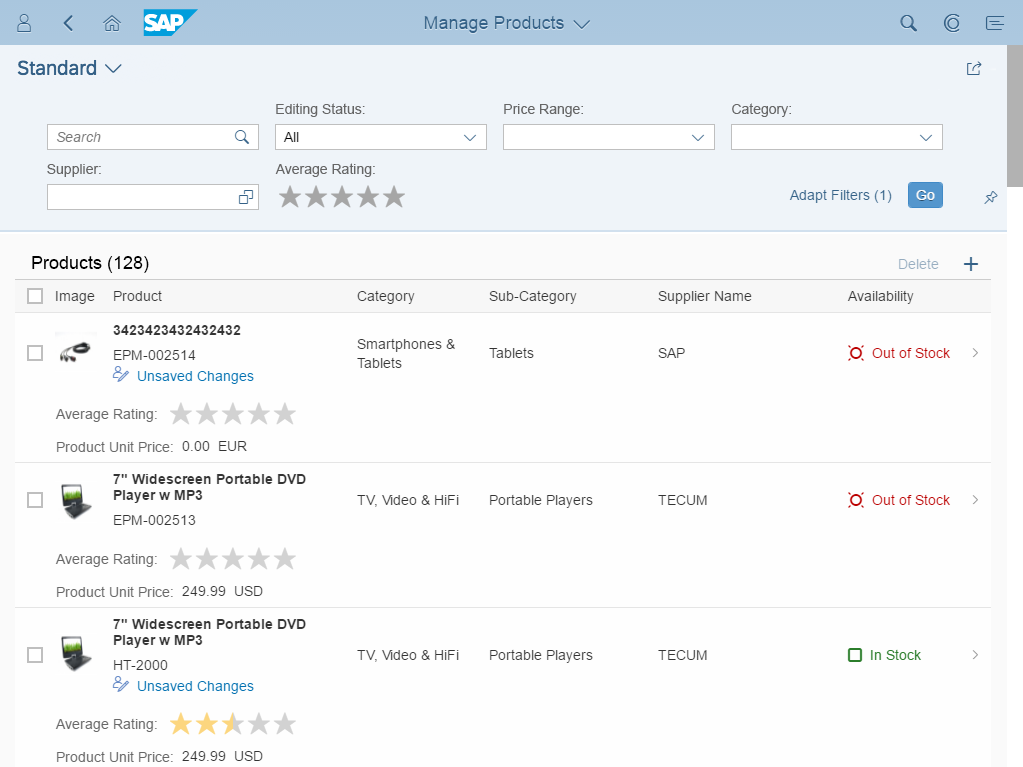
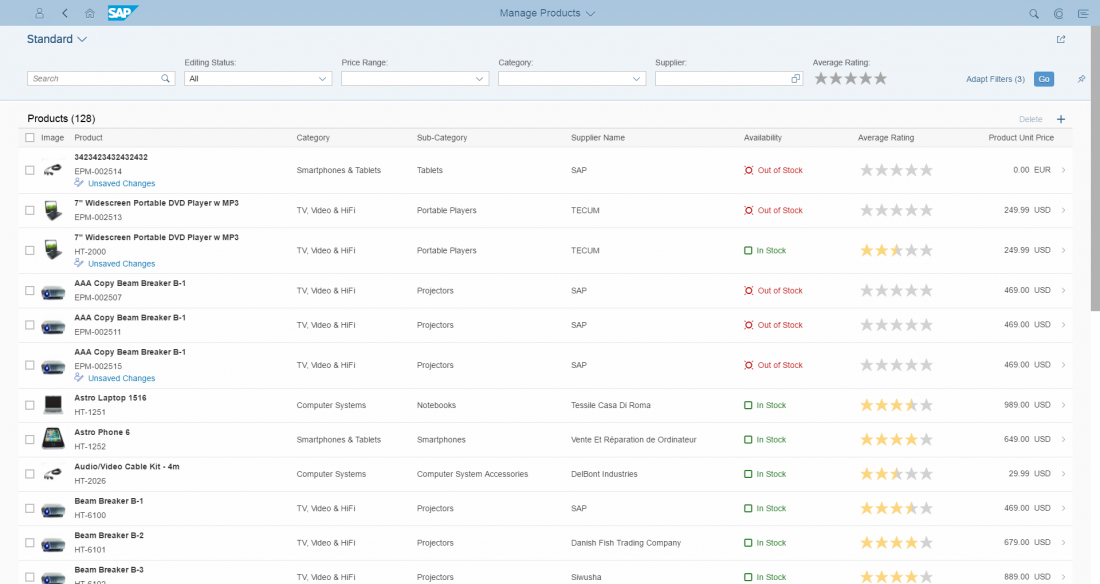



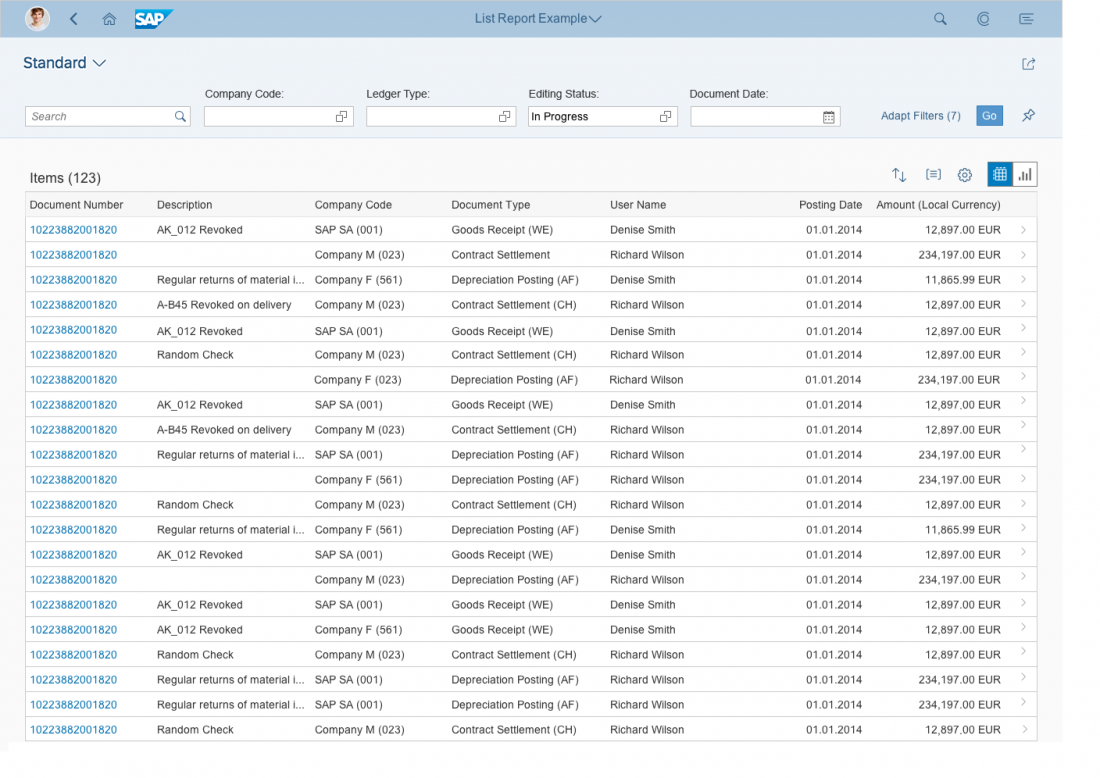
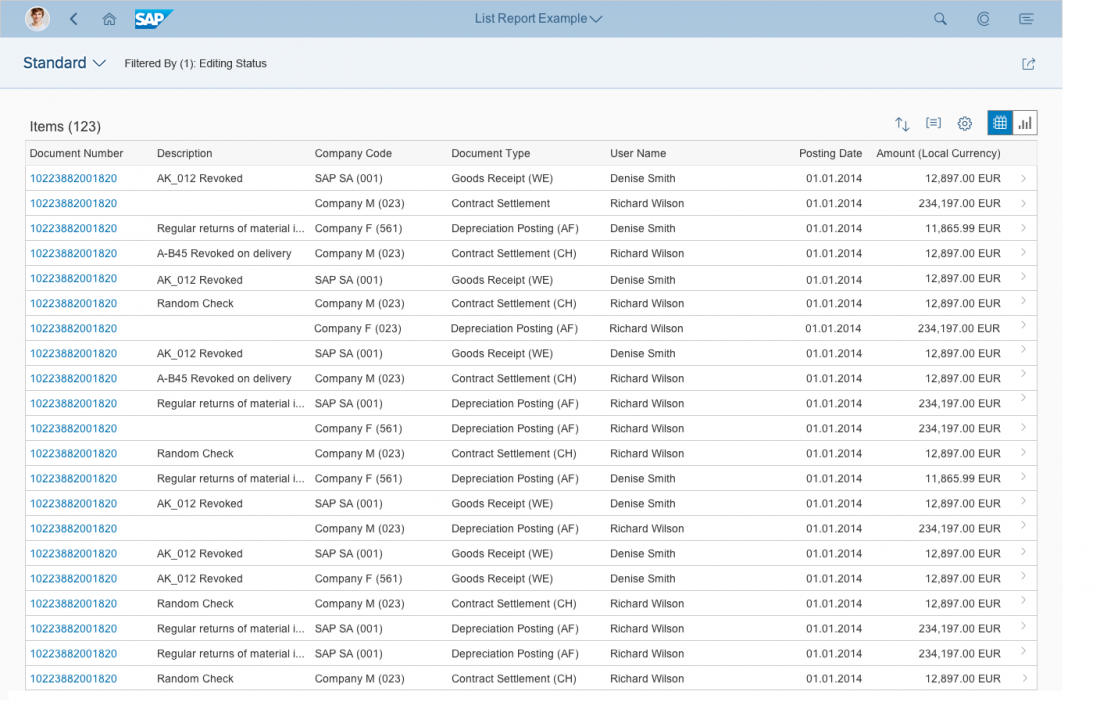








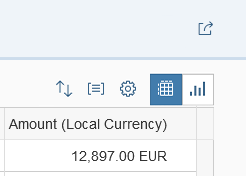
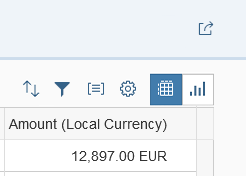

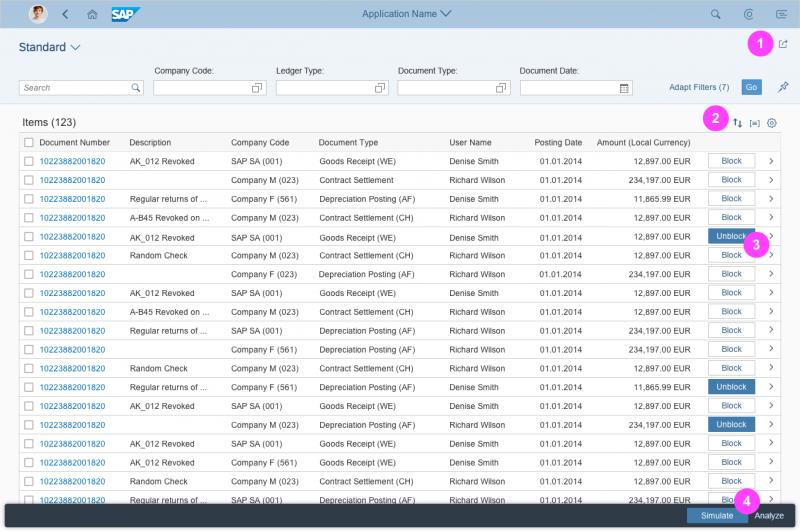
 Your feedback has been sent to the SAP Fiori design team.
Your feedback has been sent to the SAP Fiori design team.